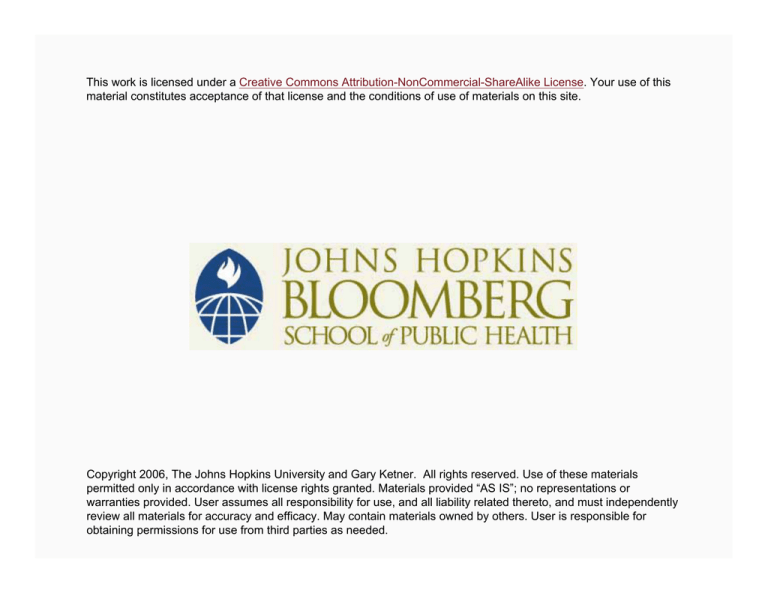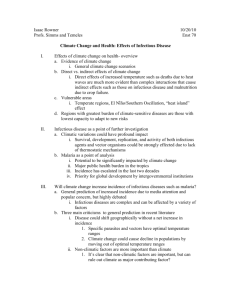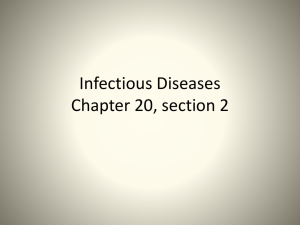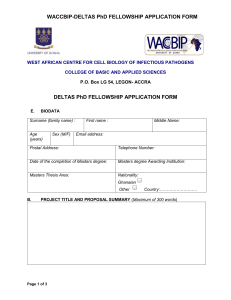
This work is licensed under a Creative Commons Attribution-NonCommercial-ShareAlike License. Your use of this
material constitutes acceptance of that license and the conditions of use of materials on this site.
Copyright 2006, The Johns Hopkins University and Gary Ketner. All rights reserved. Use of these materials
permitted only in accordance with license rights granted. Materials provided “AS IS”; no representations or
warranties provided. User assumes all responsibility for use, and all liability related thereto, and must independently
review all materials for accuracy and efficacy. May contain materials owned by others. User is responsible for
obtaining permissions for use from third parties as needed.
Pathogens: Nature and Transmission
Gary Ketner, PhD
Johns Hopkins University
Module 2 Introduction, by Dr. Vern Carruthers, PhD
Module 2: pathogens and host immunity
− Existing and emerging infectious diseases
− Principles of microbial transmission and host
responses
− Led by Dr. Gary Ketner
X Professor of Molecular Microbiology and
Immunology
3
Section A
Introduction
Infectious Disease
Disease caused by replicating agents transmissible to
humans from another person, an animal, or the
environment
5
Infectious Disease Health Burden: All Nations
Source: Communicable Diseases 2002, WHO 2003
Continued
6
Infectious Disease Health Burden: All Nations
Source: Communicable Diseases 2002, WHO 2003
7
Encouraging Trends
Crude death rate (infectious disease) USA 1900–1996
Source: Adapted from Armstrong et al. JAMA. 1999;281:6–66.
8
Public Health Challenges of Infectious Diseases
We have not yet applied existing tools to many
infectious diseases with effective interventions (polio,
measles)
Many of the remaining infectious disease problems are
refractory to existing tools (HIV, malaria)
Emerging diseases (HIV, SARS, new influenza strains,
drug resistant pathogens) illustrate that, as a public
health issue, infectious diseases will always be
important
Continued
9
Public Health Challenges of Infectious Diseases
Application of existing tools to remaining
“controllable” infectious disease
Development of new tools applicable controlling
refractory and emerging infectious disease
− The development of new tools will be critically
dependent upon knowledge of the biology of
disease and pathogen
10
A Generalized Infectious Cycle
Environment
In or on
human host
Continued
11
A Generalized Infectious Cycle
• Invasion
• Proliferation
• Evasion of
defenses
Environment
In or on
human host • Exit
• Pathogenesis
Continued
12
A Generalized Infectious Cycle
• Survival
• Invasion
• Transit (via
water, food, air,
contact, vectors)
• Proliferation
• Multiplication
or development
in intermediate
hosts, reservoirs
or environmental
niches
• Evasion of
defenses
Environment
In or on
human host • Exit
• Pathogenesis
13
Infectious Agents
Prions
Viruses
Bacteria (prokaryotes)
Eukaryotes
− Fungi
− Protozoan parasites (single cells)
− Metazoan parasites (multicellular)
14
Prions
Creutzfeldt-Jacob disease (CJD), vCJD, Mad Cow (and
early-onset Alzheimer’s disease?)
Single protein molecules (or small aggregates) (PrP)
Continued
15
Prions
No nucleic acid
− Prion protein
encoded by cellular
DNA
Aberrant folding
propagates
16
Fungi
Eukarotes (contain defined
nuclei)
Fairly closely related
(biochemically) to humans
Fungal disease
comparatively rare
− Seen mostly in the
immunocompromised
Intractable: drugs poor
No vaccines
Candida albicans
17
Metazoan Parasites
Multicellular eukaryotes
Agents of many
important diseases
(mostly tropical)
− Schistosomiasis
− Filariasis
Drug treatment available
for a several diseases
No vaccines
Transmission control
central
18
Section B
Viral Pathogens
Viruses
Obligate intracellular parasites
− Perform replicative functions only in living cells
X Dependent upon host cells for:
− Energy
− Biochemical precursors (amino acids,
nucleosides)
− Protein synthesis
− Nucleic acid synthesis (to varying extents)
− Transmitted as metabolically inert particles
(virions)
20
Viruses
Virions all have:
− Nucleic acid (DNA or RNA)
X 5,000 to 250,000 bases (human: 3 x 109)
X 3 to 100+/- genes (human: 50,000)
− Protective protein coat
X 1 to 50 different types, a few to 1000s of
copies of each
− Mechanism for specific attachment to host cells
X (Commonly targets for immunity)
And may also have:
− Membranes derived from the host cell
− Enzymes (HIV reverse transcriptase, for example)
− Specialized attachment structures
21
Virion Morphology
Human adenovirus
(colds, DNA)
Ebola virus Zaire
(hemorrhagic fever, RNA)
Continued
22
Virion Morphology
T4 virus of E. coli,
( DNA)
23
Poliovirus
Etiologic agent of paralytic poliomyelitis
Wild polio eradicated in the West
− 1,919 cases worldwide in 2002 (down from
~350,000 in 1988)
Decrease due to effective vaccines and successful
immunization campaigns
24
Poliovirus: Infectious Cycle
Transmission by fecal-oral route via contaminated
water
Primary replication/multiplication is in lymphoid cells
(specialized cells of the immune system) especially in
the gut
Virus shed primarily into the gut, excreted in the feces
Some virus also enters the blood and reaches other
susceptible cells
These include anterior horn cells (motor neurons),
which innervate muscle
Destruction of these cells can result in paralysis
− Disease is not a consequence of an essential step
in the virus’s life cycle
25
Poliovirus Virion
30 nM diameter virion
contains 60 copies
each of four proteins
(encoded in the viral
RNA)
Viral RNA is a single
strand with mRNA (+)
polarity, is about 8000
bases long, and
encodes 11 proteins
Virion is nonenveloped and
contains no enzymes
26
Poliovirus: Intracellular Replication
1. Attachment to cell via
specific receptor
(Vpr) on cell
membrane
2. Virus entry
(endocytosis);
extrusion of RNA into
cytoplasm
3–5: Translation of viral
RNA; processing of
polyprotein;
formation of RNA
replicase protein
Source: Adapted from Flint et al., Principles of Virology, ASM Press, 2000
Continued
27
Poliovirus: Intracellular Replication
8-10. Replication of
viral RNA
11. Continued
translation and
processing;
formation of virion
proteins
12. Assembly of (+)
RNA and virion
proteins into new
virions
13. Virion release into
the gut
Source: Adapted from Flint et al., Principles of Virology, ASM Press, 2000
28
Potential Targets: Viruses
Entry
− Immunization
Uncoating
− Drugs (amantadine)
Nucleic acid synthesis
− Drugs (nucleoside analogs—e.g., AZT)
Translation
− Interferons
Protein processing
− Drugs (protease inhibitors)
29
Section C
Bacterial Pathogens
Bacteria Are Living Cells
Living cells
− Membrane bound; with or without cell walls
− Genetic material is DNA
− Produce energy
− Produce biochemical precursors
− Produce and translate RNA to form proteins
− Replicate DNA
− Reproduce by cell division
− Respond to environmental signals
31
Bacteria
Bacteria are prokaryotes (“before nuclei”)
− Biochemically, they are distantly related to their
eukaryotic hosts (such as humans)
X This underlies successful antibacterial drug
treatments
Bacteria are transmitted either as metabolically active
cells or dormant forms called spores
Bacteria can be professional pathogens (e.g., TB), but
many are opportunistic or facultative pathogens
32
Vibrio Cholerae
Etiologic agent of cholera, a severe
epidemic diarrheal disease
There are both pathogenic and nonpathogenic V. Cholerae strains
− Close relatives are normal
estuarine organisms
Transmission to humans happens
occasionally from this source
− During epidemics, transmission
is fecal-oral via water
Infection control is by cleanliness of
water and food
− A good vaccine is not available
33
V. Cholerae: Infectious Cycle
Bacteria are ingested in contaminated water or food
Bacteria pass through the stomach to the gut, where
they colonize the surface of the small intestine
− Ability to colonize the gut is the key determinant
of ability to cause disease
− Colonization is dependent on a number of
identified and unidentified genetic “virulence
factors”
− V. cholerae is non-invasive and does not cause
much tissue damage (differing from some other
bacterial and viral pathogens)
Continued
34
V. Cholerae: Infectious Cycle
Multiplication occurs on the surface of the gut.
Cholera toxin induces diarrhea, washing organisms
out into the environment
− Pathogenesis greatly increases efficiency of
transmission
Death is from hypotensive shock and circulatory
collapse
35
Cholera Toxin
Cholera toxin (CT) induces
diarrhea by stimulating secretion
in the intestine
− CT secreted by V. cholerae in
response to colonization
− CT binds to intestinal cells (R
subunit)
− CT A subunit enters cell
− A1 indirectly activates a
cellular pump that causes Cland HCO3- secretions across
epithelium; water , K+, and
Na+ are secreted passively
Continued
36
Cholera Toxin
Effects of the toxin are
independent of the continued
presence of the bacteria (for a
few days)
− Antibiotics are not
immediately effective in
treating disease
37
Cholera Treatment
Treatment is by fluid/salt replacement
Salt solutions are not effective due to poor uptake
IV infusions of salt solutions are effective
− Expensive
− Require trained personnel
− Involve risk of other infection
Discovery in the 1960s of glucose-dependent cotransport of Na+ and water in the intestinal epithelium
Oral rehydration solution now standard (glucose or
starch plus appropriate salts)
− Inexpensive
− Skilled personnel not required
− Immediately available (no hospitalization required)
38
Virulence
Virulence is the ability of an organism to cause disease
Most pathogens exist in forms with varying virulence
− Not all V. cholerae are virulent, nor are the large
number of closely related Vibrios
A variety of genetically-determined properties of V.
cholerae underlie virulence
− Ability to move through mucus
− Ability to attach to intestinal epithelium
− Ability to produce CT
− Ability to evade pre-existing immunity
X For example, when El Tor V. cholerae was
replaced with O139
39
Virulence Determinants
Mechanisms/proteins/genes are of interest
− Identification of virulent strains in the environment
− Targets for intervention (chemotherapeutic or
immune)
− Targets for attenuation (vaccine design)
X CVD 111 cholerae O1 El Tor Ogawa ∆ (ctx, zot,
cep, ace), ins (ctxB, merr)
− Prediction of emergence of virulent strains
Identification of virulence genes
− Genomics: comparison of DNA sequence of known
virulent and non-virulent strains
− Construction and characterization of mutant
strains in model systems
40
Virulence Genes
Relevant Genes Associated with Virulence and Environmental Properties in V. Cholerae
Gene name
aphAB
chi genes
£rC
irgA
msh genes
ompU, T
rfb genes
rtxA
toxRS
wav genes
vps genes
ace
cep
ctxAB
orfU
rst genes
zot
acfABCD
aldA
tagA
tcpA
tcpPH
toxT
Function
Regulatory proteins
Chitinase homologues
Flagellar transcriptional regulator
Iron-regulated outer membrane protein
Type IV pili (mannose-sensitive hemagglutinin)
Outer membrane porins
O-antigen biosynthesis
“Repeats in toxin” toxin, cross-links cellular actin
Transmembrane regulatory proteins
LPS core oligosaccharide synthesis
Exopolysaccharide synthesis
M13 gene VI homologue formerly ‘accessory enterotoxin’
M13 gene VIII homologue formerly ‘core-encoded pili’
CT subunits A, B
M13 gene III homologue
regulation, integration, replication
M13 gene I homologue formerly ‘zonula occludens toxin’
Accessory colonization factors, function unknown
Aldehyde dehydrogenase ToxT-activated
ToxT-activated gene
Toxin co-regulated pili major subunit (type IV pili)
Transmembrane regulatory proteins
Virulence transcriptional activator
Location
chromosome
chromosome
chromosome
chromosome
chromosome
chromosome
chromosome
chromosome
chromosome
chromosome
chromosome
CTXP phage
CTXP phage
CTXP phage
CTXP phage
CTXP phage
CTXP phage
VPI
VPI
VPI
VPI
VPI
VPI
Virulence
(v)/(e)
v
e
v/e
v
e
v/e
v/e
?
v/e
v/e
e
v
v
v
v
v
v
v
?
?
v
v
v
41
Virulence and Mobile Genetic Elements
Half of V. cholerae virulence-associated genes lie on
mobile genetic elements
− DNA sequences that can be transmitted from one
strain to another (or across species barriers)
X Vibrio Pathogenicity Island (Toxin coregulated Pili )
X CTX phage (CT)
Populations that interact to produce cholera
epidemics include humans, Vibrio, viruses, and other
mobile genetic elements
− Transfer of mobile virulence determinants may
underlie emergence of virulent strains
42
Section D
Eukaryotic Pathogens/Malaria
Eukaryotic Pathogens
Living cells
− Membrane bound; with or without cell walls
− Genetic material is DNA
− Produce energy
− Produce biochemical precursors
− Transcribe and translate RNA
− Replicate DNA
− Reproduce by cell division
− Respond to environmental signals
Unlike bacteria, eukaryotic pathogens are
(biochemically) rather closely related to humans
− Complicates chemotherapy
44
Malaria: The Disease
Responsible for about 300
million acute cases/year
and about 1 million deaths
(mostly children)
Acute malaria includes
periodic fever, diarrhea, aches
Most deaths result from severe
malaria (severe anemia, hypoglycemia, circulatory
collapse) or cerebral malaria
− The unifying pathogenic mechanism is reduced
tissue oxygenation (anemia, sequestration)
45
Malaria: Pathology
Etiologic agent is a
single-cell eukaryotic
parasite of the genus
Plasmodium
− Falciparum
(severe malaria)
− Vivax
− Ovale
− Malariae
Vector-borne
− Transmitted by female mosquitoes of the genus
Anopheles
Complex life cycle
Photo source: (www.dpd.cdc.gov/dpdx/images/ParasiteImages/M-R/Malaria/malaria_LifeCycle.gif)
46
Malaria Life Cycle
Continued
47
Malaria Life Cycle
48
Malaria Control: The Vector
Vector essential for
transmission (Ronald
Ross)
− Control of breeding
sites (water)
− Insecticide use
(residual sprays
in/around houses)
− Reduction in
exposure (bed nets,
screens, repellants)
An. gambiae
Continued
49
Malaria Control: The Vector
Difficulties of target control
− Target species must be determined and programs
must be designed
X Not all mosquitoes (nor all anopheles) transmit
malaria
X Species differ in breeding, feeding, resting
behaviors
− Costs of vector control
X Programs are hard to sustain when the
problem appears to be solved
− Vectors develop insecticide resistance (with
inappropriate use)
− Political opposition to insecticide use/
environmental modification
50
FW5
Malaria Control: Vector Capacity
Complications of vector control: in some areas, huge
reductions in vector populations would be needed to
affect transmission (1000x)
51
Slide 51
FW5
AM
FWANG, 11/11/2004
Malaria Control: Drugs
Chloroquine
− Discovered prior to WW II
− Cheap and effective
− Non-toxic to humans
− Acts against the blood stage (merozoites) by
interfering with heme detoxification
− Resistance to chloroquine developed in the 1960s,
and some degree of resistance is now seen in all
endemic regions in Africa
Mefloquine
Primaquine
Pyrimethamine
Artemesinin (Quinhaosu)
52
Malaria Control: Vaccination
No effective malaria vaccines exist
Major efforts to produce vaccines against multiple life
stages are underway
− Sporozoites (infection-blocking)
− Hepatic stages (early post-infection)
− Blood stages (reduce symptoms)
− Gametes/gametocytes (transmission-blocking)
Technologies include vaccination with recombinant
protein, DNA, and vectored vaccines
53
Malaria and Infectious Disease: Summary
Using these three strategies in combination, it should
be possible to substantially reduce malaria:
− Vaccination
− Development of new drugs
− Mosquito control
The biology of infectious organisms underlies
prevention and treatment strategies
Knowledge of the ecology of infectious organisms
provides insight into population-based control
strategies
54








